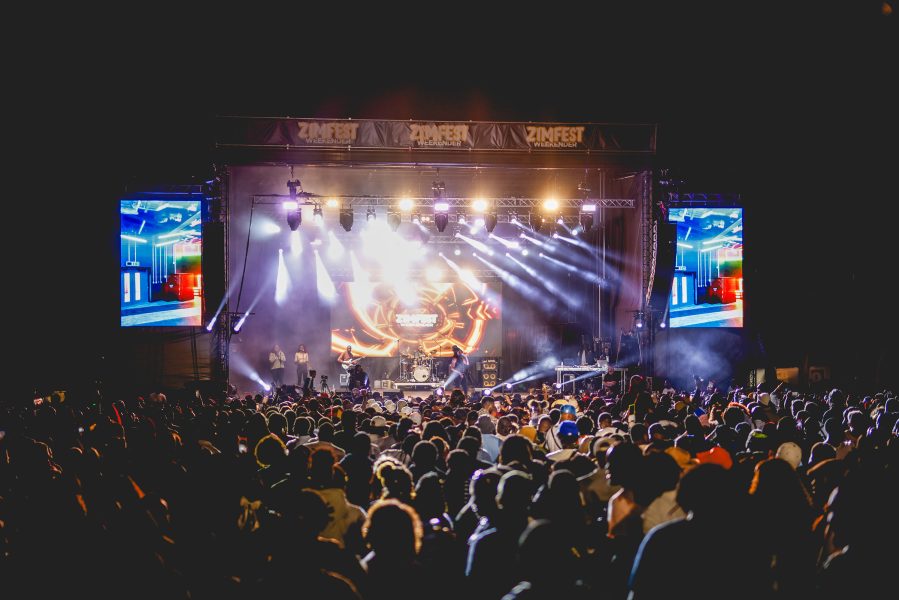RCF UK partner, JPS Sound & Light, fielded 108 RCF loudspeaker enclosures at the recent Zimfest Live 2024 festival in Hertfordshire — now celebrating its 25th year.
Involved with this event for the past five years, John Southee’s company has watched the event—a celebration of Zimbabwean music, culture and music—mature from its old Colesdale Farm site near Potters Bar to the premium Hertfordshire County Show Ground outside St. Albans where up to 10,000 people from across the UK congregate over the two days.
JPS were tasked with providing a complete technical infrastructure (sound, lighting and video as well as camera crew) — populating two stages, the enlarged main stage and a six-pole Big Top. “The SmartStage180 provided a massive 15m by 12m stage area, with a 10m high roof. This offered an impressive 20-ton weight-loading and additional wings for video, taking the stage to 22m wide,” Southee explained.
In both areas the colourful crowds were treated to premium audio from RCF’s HDL 30-A active two-way line array — powered by 2200W of Class D amplification power, and featuring the proprietary FiRPHASE linear phase filter, while the system was further optimised by RCF’s powerful RDNet network management platform.
JPS had upgraded its inventory from HDL 20-A to the massive HDL 30-A front line system, complete with powerful SUB 9006-AS (2 x 18”) and SUB 9007-AS (2 x 21”) subwoofers during lockdown. “Everyone thought I was crazy,” he said. “The bulk of our work with RCF kit is during the outdoor festival season and this is definitely one of our largest deployments.”
The main stage, where Winky D and South African Amapiano virtuoso Daliwonga headlined, was equipped with two PA wings of 10 HDL 30-A, with eight SUB 9006-AS handling the LF. These were supported by two delay towers, each with four further HDL 30-A set 60m back from the stage, and further subs. JPS also provided 10 TT25-CXA, RCF’s premium floor monitors for artists foldback.
“For Zimfest we hang the main PA in a very tight arc — we don’t try and throw it miles. By focusing the sound on the front and having the delays nearer the perimeter, it meant we could turn them down without affecting the listening experience for those in front of the stage,” continued Southee.
In the large four-pole Big Top, JPS hung five-a-side HDL30-A with six of the super powerful SUB 9007-AS, offering 7,200W peak power.
Explaining the rationale behind the respective designs John Southee said this was to account for the different genres. While main stage was populated by live acts (functioning on day one only) the Big Top consisted of back-to-back DJs and live PAs, operating across the entire weekend. Here there was additional fills in the shape of eight RCF NX15 and a further pair of TT25-CXA for monitoring.
The subwoofers in both tents had been designed in cardioid (in L/R stacks). “This was to protect sound escape and minimise rear rejection on the other side of the road where the bulk of the houses were situated. Had they not had a catwalk on the main stage we would have used an end fire configuration which we generally prefer when it comes to back cancellation.”
As would be expected close attention needed to be paid to the offsite sound limits, and these were set and monitored by Matt Lauezzari of Sound Licensing. “It’s a very wealthy area and they are not used to having festival crowds,” acknowledges Southee. “We have to observe strict offsite limits to avoid noise pollution — and with a conventional rig you’d have little chance of controlling the sound.”
Of RDNet, RCF’s proprietary management network and control platform, he said it was invaluable in providing data that the techs wouldn’t physically have time to address onsite, while during a live performance enabling the behaviour of every driver to be monitored.
John Southee credits the assiduous prep time put in at design stage, and assistance provided by RCF UK’s tech support. “There is a lot of pre-planning using prediction software before we go to site, calculating the different angles, and so on.”
Production Manager, Josh Silver confirmed that JPS had managed to strike the difficult balance between delivering the customer experience while maintaining strict offsite thresholds to meet licensing requirements. “Overall, it was managed very well — partly since we added delay towers this year. JPS also ensured there was no bleed between main stage and Big Top, which was remarkable, considering how close together they were.”
JPS personnel on duty were FOH Technicians, Lee Wickens on the main stage and Tomos Williams at the Big Top. The event is promoted by Marvin and Jade Muchando of Redcliffe Management.


